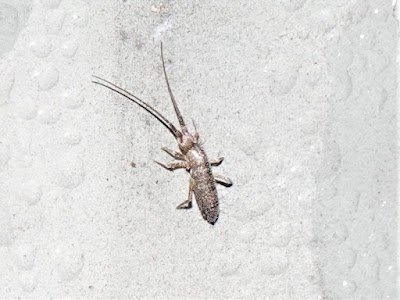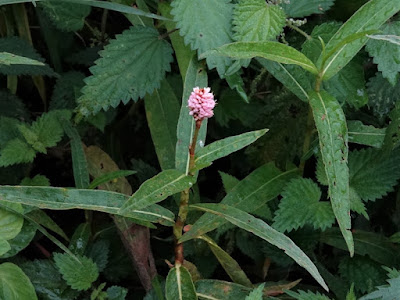10.0°C > 13.0°C: A few clear patches early: cloud increasing and lowering with light rain by 10:35. Very light south-westerly breeze. Very good visibility.
Sunrise: 07:09 BST
+ = my first sighting of this species at this site this year.
++ = new species for me at this site.
* = a species photographed today
A quiet morning with no highlights
Priorslee Balancing Lake: 05:35 – 09:30
+ = my first sighting of this species at this site this year.
++ = new species for me at this site.
* = a species photographed today
A quiet morning with no highlights
Priorslee Balancing Lake: 05:35 – 09:30
(200th visit of the year)
Nothing to celebrate my 200th visit of the year.
Bird notes:
- No large gulls settled on the water early as sometimes happens. It seems it needs at least one bird to settle before the others feel brave-enough to do so. All those I noted flying over were Lesser Black-backed Gulls with adults predominating.
- After c.08:00 a sizeable arrival of mainly Lesser Black-backed Gulls with, I would, a higher proportion of immatures.
- A female Sparrowhawk flew E overhead c.06:35. A pair flew North together over the football field c.07:20 with the smaller male doing an undulating display flight ahead of the female.
Counts of birds noted flying over:
- 7 Canada Geese: a single and sextet inbound
- 4 (2♂) Mallard
- 7 Feral Pigeons: together
- 1 Stock Dove
- 61 Wood Pigeons
- 41 Lesser Black-backed Gulls
- 96 Jackdaws
- 176 Rooks
- 3 Pied Wagtails
Warblers noted (the number singing in brackets):
- 6 (0) Chiffchaffs
Hirundines etc., noted:
None
Counts from the lake area:
- 4 Canada Geese: two present when I arrived; two more flew in; all departed
- 2 + 2 Mute Swans
- 2 (1♂) Mallard
- 2 (0♂) Tufted Duck
- 5 Moorhens
- 130 Coots
- 2 Great Crested Grebes
- 61 Black-headed Gulls: 49 counted on the football field c.07:20. Just 12 more on the lake at that time.
- *8 Herring Gulls
- *115 Lesser Black-backed Gulls
On or around the street lamp poles at dawn:
Counts from the lake area:
- 4 Canada Geese: two present when I arrived; two more flew in; all departed
- 2 + 2 Mute Swans
- 2 (1♂) Mallard
- 2 (0♂) Tufted Duck
- 5 Moorhens
- 130 Coots
- 2 Great Crested Grebes
- 61 Black-headed Gulls: 49 counted on the football field c.07:20. Just 12 more on the lake at that time.
- *8 Herring Gulls
- *115 Lesser Black-backed Gulls
On or around the street lamp poles at dawn:
Moths:
- none
- none
Other things:
- 3 Spotted-winged Drosophila (Drosophila suzukii)
- *++1 fly sp. Tachypeza nubila
- *6 springtails Pogonognathellus longicornis
- 1 White-legged Snake Millipede (Tachypodoiulus niger)
- *1 spider Clubiona sp.
- 3 Bridge Orb-web Spiders (Larinioides sclopetarius)
Noted later:
- 3 Spotted-winged Drosophila (Drosophila suzukii)
- *++1 fly sp. Tachypeza nubila
- *6 springtails Pogonognathellus longicornis
- 1 White-legged Snake Millipede (Tachypodoiulus niger)
- *1 spider Clubiona sp.
- 3 Bridge Orb-web Spiders (Larinioides sclopetarius)
Noted later:
Butterflies:
- unidentified in flight only
- unidentified in flight only
Bees / wasps etc.:
- Common Wasp (Paravespula vulgaris)
- Common Wasp (Paravespula vulgaris)
Other Flies etc.:
- Muscid fly Phaonia rufiventris
- Muscid fly Phaonia rufiventris
Beetles:
- *Alder Leaf Beetle (Agelastica alni)
- *Alder Leaf Beetle (Agelastica alni)
Bugs:
- *Red-legged Shieldbug (Pentatoma rufipes): dead in web
- *Red-legged Shieldbug (Pentatoma rufipes): dead in web
Spiders:
- Nursery Web Spider (Pisaura mirabilis)
- Nursery Web Spider (Pisaura mirabilis)
Molluscs:
- White-lipped Snail (Cepaea hortensis)
- White-lipped Snail (Cepaea hortensis)
Also
I found these plants in flower, additions to the list I provided on Thursday (28th)
- *Slender Speedwell (Veronica filiformis)
- *++Autumn Hawkbit (Scorzoneroides autumnalis (but Leontodon autumnalis in my ancient Flora))
- Prickly (or Spiny) Sow-thistle (Sonchus asper)
- *Slender Speedwell (Veronica filiformis)
- *++Autumn Hawkbit (Scorzoneroides autumnalis (but Leontodon autumnalis in my ancient Flora))
- Prickly (or Spiny) Sow-thistle (Sonchus asper)
The sunrise produced a few salmon tones before...
...soon fading with an interesting-shaped cloud appearing.
Probably a Herring Gull. The detail of black on the outer primaries (wing-tips) is one definitive way to separate Herring, Yellow-legged and Caspian Gulls. Sadly here the moult is incomplete and not all eight outer primaries are fully grown.
A motley collection of Lesser Black-backed Gulls (and two Coots at the back). Six of them are adults and illustrate just how variable these birds can be, especially in the extent of the dark markings on the head.
This fly is a new insect for me. It is Tachypeza nubila. This small (0.1" (or 3mm in new money)) fly with dark wings is unusual in having a swollen base to front legs.
This Alder Leaf Beetle (Agelastica alni) seems to have not folded its wings properly as they are sticking out from under the elytra (wing cases).
I tried to rescue this Red-legged Shieldbug (Pentatoma rufipes) from a spider's web but I was too late. The spider had already eaten the insides.
Yesterday I showed what I thought were two Common House Spiders (Eratigena atrica) in a deadly embrace. Exactly what has happened since I am unsure. Perhaps these are exoskeletons? A springtail Pogonognathellus longicornis scurries away.
While mentioning springtails here is perhaps my best photo to date. Strangely this one has no bands on the abdomen so perhaps it is a different species.
This spider seems to be one of the Clubiona species. One of my apps suggested it was a garden ghost spider without specifying the scientific name. Reference to the internet places this is the genus Hibana which is exclusively a New World family.
Not my best: Slender Speedwell (Veronica filiformis).
This may or may not be an Autumn Hawkbit flower (Scorzoneroides autumnalis) (it is Leontodon autumnalis in my ancient Flora!). All the "hawk-things" are very difficult to identify so I am relying on my app.
Plane of the day. This is a Jabiru J430 flying out of Mid-Wales Airport at Welshpool. The Jabiru is an Australian-design with two or, as here, four seats. It is in shared ownership with the 'KH' being the airport manager.
(Ed Wilson)
------------------------------------------------------------------------------------------------------
The Flash: 09:35 – 10:35
(186th visit of the year)
Bird notes:
- Three Gadwall again: two drakes this time.
- A Kingfisher seen and heard dashing along the North side. I did not where it perched.
Bird(s) noted flying over here:
None
Warblers noted:
- 1 (0) Chiffchaff
Hirundines etc., noted:
- 1 (0) Chiffchaff
Hirundines etc., noted:
None
Noted on / around the water:
- 34 Canada Geese
- 4 Greylag Geese: of these three arrived together.
- 2 + 4 Mute Swans
- *3 (2♂) Gadwall
- 37 (26♂) + 4 (1 brood) Mallard
- 1 (1♂) all-white feral duck
- 49 (>22♂) Tufted Duck
- *2 brownhead Goosander
- 14 Moorhens
- *49 Coots
- 4 + 1 (1 brood) Great Crested Grebes
- 17 Black-headed Gulls
- 2 Cormorants
- *1 Grey Heron
- 1 Kingfisher
On / beside the street lamp poles etc. around the water etc.:
Bottom right are two drake Gadwall with dark tails. Bottom left is a preening duck Gadwall. The only Grey Heron present today is also preening.
- 34 Canada Geese
- 4 Greylag Geese: of these three arrived together.
- 2 + 4 Mute Swans
- *3 (2♂) Gadwall
- 37 (26♂) + 4 (1 brood) Mallard
- 1 (1♂) all-white feral duck
- 49 (>22♂) Tufted Duck
- *2 brownhead Goosander
- 14 Moorhens
- *49 Coots
- 4 + 1 (1 brood) Great Crested Grebes
- 17 Black-headed Gulls
- 2 Cormorants
- *1 Grey Heron
- 1 Kingfisher
On / beside the street lamp poles etc. around the water etc.:
Nothing noted
Noted elsewhere around The Flash:
Noted elsewhere around The Flash:
Bees / wasps etc.:
- Honey Bee (Apis mellifera)
- Common Carder Bee (Bombus pascuorum)
- Honey Bee (Apis mellifera)
- Common Carder Bee (Bombus pascuorum)
Beetles:
- Alder Leaf Beetle (Agelastica alni)
- Alder Leaf Beetle (Agelastica alni)
Molluscs:
- *Brown-lipped Snail (Cepaea nemoralis)
- *Brown-lipped Snail (Cepaea nemoralis)
Fungus:
- *++bracket fungus Ganoderma sp., perhaps G. lipsiense aka Artist's Fungus
- *++bracket fungus Ganoderma sp., perhaps G. lipsiense aka Artist's Fungus
Flowers
And flowers noted though not logged on 28th at either here or at the Balancing Lake:
- *Bistort (Polygonum bistorta)
- *Bistort (Polygonum bistorta)
The drake Tufted Duck with some type of growth on its neck. When I photographed it two days ago the growth looked spherical. Perhaps it has burst? Quite separately note how the white flanks are spreading from the front as it moults in to breeding plumage. Unusually it still show some white in the under-tail.
The two brownhead Goosanders. The closer bird has the loose head plumes that suggests it is a duck. The other bird may have a slightly browner head (though it could be the angle of the light) and seems to have a smoother head profile suggesting it is, or will be, a drake.
I think a Brown-lipped Snail (Cepaea nemoralis).
A bracket fungus Ganoderma sp. My app suggested it as perhaps G. lipsiense aka Artist's Fungus. However that scientific name is not in NatureSpot which firstly suggests Artist's Fungus is G. applanatum; and secondly note that it is less common than Southern Bracket (G. australe) with separation is only possible by microscopic examination of the spores! I found this on a the trunk of a dead Silver Birch tree (Betula pendula).
This flower is Bistort (Polygonum bistorta).
This is Imperforate St John's-wort (Hypericum maculatum). At the lake this flower was just about finished. Here it looks as if a late plant is about to flower.
(Ed Wilson)
Noted in the Priorslee Avenue tunnel:
(Ed Wilson)
------------------------------------------------------------------------------------------------------
Noted in the Priorslee Avenue tunnel:
Moths:
- none
- none
Other things:
- 1 *cranefly Tipula lateralis
- 2 owl midges Psychodidae sp.
- 1 Common Rough Woodlouse (Porcellio scaber)
- 4 White-legged Snake Millipedes (Tachypodoiulus niger)
- 1 harvestman Leiobunum rotundum
- usual array of unidentified spiders
- 1 *cranefly Tipula lateralis
- 2 owl midges Psychodidae sp.
- 1 Common Rough Woodlouse (Porcellio scaber)
- 4 White-legged Snake Millipedes (Tachypodoiulus niger)
- 1 harvestman Leiobunum rotundum
- usual array of unidentified spiders





















